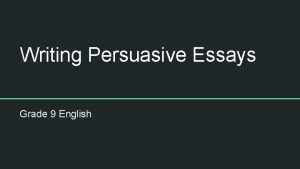How to Right an Essay Argumentative Essay How








- Slides: 8

How to Right an Essay Argumentative Essay

How to Write an Argumentative Essay An argumentative essay uses reasoning and evidence—not emotion —to take a definitive stand on a controversial or debatable issue. The essay explores two sides of a topic and proves why one side or position is the best.

The First Steps Choose a specific issue to discuss. Some debatable issues cover a wide range of topics. For example, “legalizing drugs” is too broad a subject because topics within that issue include legalizing marijuana, the effectiveness of the FDA, or whether a painkiller made in Europe should be allowed into the US. Any of these could be the sole focus of an argumentative paper. Research both sides of the topic thoroughly. Even if you know which side you want to argue, research can give you ideas for counterarguments and help your paper show balance rather than bias. Develop a working thesis that states your position on the issue and summarizes your argument’s main reasons. Your body paragraphs should explain your reasons fully.

Body Paragraphs Option #1: Present both sides of the issue, then state your opinion and explain why you chose that side. This option is useful if you did not have an opinion on the issue prior to research, or your audience is not very familiar with your topic. o One half to two-thirds of your paper explains the issue, shows the two opposing sides, and gives an assessment of each. This demonstrates that you have indeed conducted research and are an expert on the subject. o Next, when you state your position, readers might be more inclined to agree with you. o Last, explain your reasons for choosing that side without repeating ideas from previous paragraphs.

Option #2 State your opinion at the beginning. List and explain the reasons for your choice. Acknowledge the other side’s arguments; then, disprove/refute those arguments. This option is useful when your audience already has some knowledge of the issue. It allows you to be more assertive, thus making a stronger argument. Select the strongest evidence from your research and present your points—usually one point per body paragraph.

o Next, explain one or two of the opposing side’s points to show readers might object to your argument. Then, show these arguments are not reasonable, not logical, or not effective. Be sure to reassert your own viewpoint and why it is the best choice .

Final Steps: Revise and Edit Pretend that your readers are a skeptical panel or jurors. You can best convince them of your arguments by avoiding emotional or aggressive language and by using a mix of evidence types—facts, statistics, examples, expert opinions, or even personal experience. o Cite your sources! o To increase the chances that your audience will agree with you, start body paragraphs with ideas that both sides agree upon before arguing your point. o Know the other side’s strongest arguments to defend against challenges from other students or your instructor. o In your conclusion, emphasize why your topic is important, summarize your arguments, and re-state your position as the most sensible choice. Do not include new evidence or arguments.

Bibliography “Argumentative Essay. ” Essay Start. com. n. d. Web. 17 February 2012. Fleming, Grace. “How to Write an Argument Essay. ” About. com. The New York Times Company, n. d. Web. 17 February 2012.
 Right product right place right time right price
Right product right place right time right price Right time right place right quantity right quality
Right time right place right quantity right quality The right man on the right place at the right time
The right man on the right place at the right time Argumentative writing vs persuasive writing
Argumentative writing vs persuasive writing Explanatory vs argumentative essay
Explanatory vs argumentative essay Whats an argumentative essay
Whats an argumentative essay Argumentative essay structure
Argumentative essay structure Year 9 essay writing examples
Year 9 essay writing examples Argumentative essay conclusion
Argumentative essay conclusion















